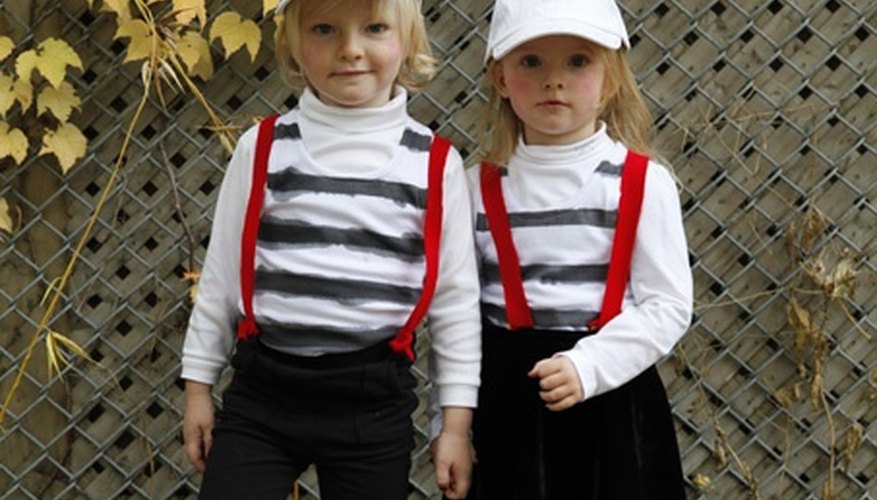Tweedledee and Tweedledum are the two boys from Lewis Carroll's book "Alice in Wonderland." Their roles centre around a rhyme where they agree to quarrel before forgetting about it when they're scared away by a crow. While the names "Tweedledee" and "Tweedledum" are popularly known for their roles in the story, they have also become a common term used to describe two people who are alike. As you plan your costumes for Tweedledee and Tweedledum, the most important thing to remember is that both costumes should look nearly the same.
Ideas from Lewis Carroll
In his book, Carroll gives several specific clues to the appearance of the Tweedles. When they first appear, he describes them as each respectively having a collar upon which "Dee" or "Dum" was written on the front. Alice suspects that "Tweedle" is written on the back, before she finds out if this is so, she is interrupted by them. The only other clues that Carroll gives of their appearance is that they seem friendly, playful, and "fat," according to Alice's observations.
- In his book, Carroll gives several specific clues to the appearance of the Tweedles.
- The only other clues that Carroll gives of their appearance is that they seem friendly, playful, and "fat," according to Alice's observations.
Ideas from John Tenniel
John Tenniel's illustrations in Carroll's book provide the inspiration upon which most Tweedledee and Tweedledum costumes are based. In his illustrations, the boys nearly appear like egg-shaped little men with thin legs and arms. Pillows can help in creating this body type. They are as Carroll describes, with the names on their collars, but they also wear light coloured high waters, revealing their ankles and dark lace-up shoes. They also have simple matching beanies, long-sleeved striped shirts with buttons, and bow ties.
- John Tenniel's illustrations in Carroll's book provide the inspiration upon which most Tweedledee and Tweedledum costumes are based.
- They are as Carroll describes, with the names on their collars, but they also wear light coloured high waters, revealing their ankles and dark lace-up shoes.
Ideas from Disney
In the 1951 movie version of "Alice in Wonderland", there is a clear link between Tenniel's illustrations and the movie's presentation of the boys. When first seen, they are standing much like Tenniel's illustration: serious and appearing more like egg-shaped men than boys. However, the movie was in colour, so now the Tweedles have red high waters, skinny yellow ankles without socks and black shoes. The biggest difference in costume is that instead of having striped shirts, they wear yellow long-sleeve shirts with cuffs. There is no writing on their collars, which are very large and reveal puffy blue bow ties. They also wear matching solid red caps with little yellow flags on top.
- In the 1951 movie version of "Alice in Wonderland", there is a clear link between Tenniel's illustrations and the movie's presentation of the boys.
- There is no writing on their collars, which are very large and reveal puffy blue bow ties.
Ideas from Tim Burton
Tim Burton's interpretation of the Tweedles is a darker one. The colours used are not typical of a childhood story or cartoon, and they use animation to take the face of a grown male actor and place it on bubble-like bodies with obese heads. Tim Burton has them in black highwaters with red suspenders. The highwaters reveal red and white striped socks underneath with black shoes. Their shirts are striped in black and white, closer to Tenniel's illustrations, but they are short-sleeved. These Tweedles do not wear collars, ties or hats on their bald heads.
- Tim Burton's interpretation of the Tweedles is a darker one.
- The colours used are not typical of a childhood story or cartoon, and they use animation to take the face of a grown male actor and place it on bubble-like bodies with obese heads.
